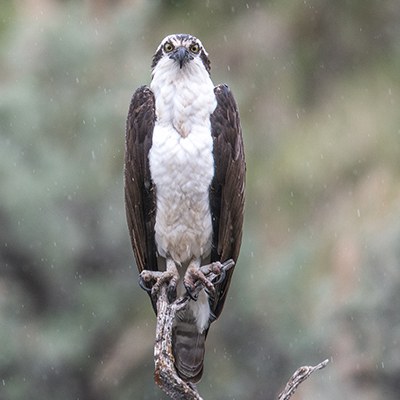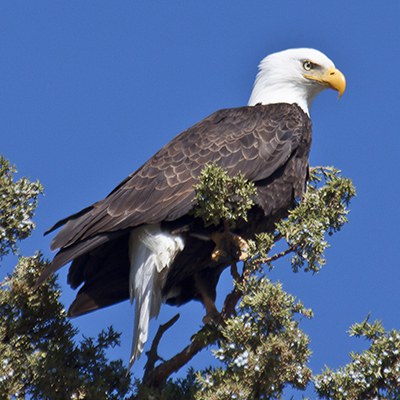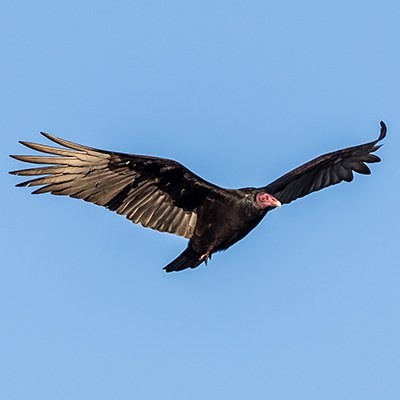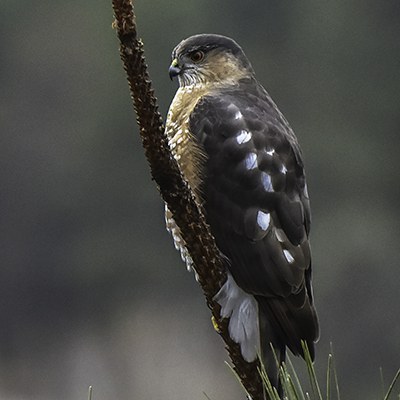When you’re outside, a high-pitched call from above grabs your attention. What is that bird? It soars through the air, barely flapping its wings. There’s a good chance that it’s a raptor.
Raptors, or birds of prey, are birds that are predatory and carnivorous. There are generally loose definitions around raptors, birds of prey, and hawks, so today we are looking at what are known as diurnal raptors. These are birds of prey that hunt during the day (diurnal). They also generally have sharp talons and hooked bills to be able to grasp and tear their prey. Of course, there’s always an exception, and this time it is vultures, who mainly eat carrion and have weak claws.
The next time you’re outside, see if you can tell if that soaring bird above you is one of the five listed below.
An incredibly common sight in Central Oregon! Red-tailed hawks are often spotted perched on power poles or fence posts along roads and fields. They are especially noticeable along Hwy 97 between Redmond and Madras, along Hwy 20 towards Sisters, and along Hwy 26 past Prineville. Red-tailed hawks are stocky with round wings and a short tail. Their tail is their most noticeable feature though (hence their name): it is a bright red to red-orange (although less distinct on juvenile birds). Red-tailed hawks are 19” in length with a wingspan of 49” and a weight around 2.4 pounds. They hunt mostly from their perch, feeding on small mammals like mice. You can also identify a red-tailed hawk by the pale underside of their flight feathers when in the air.
Keep a lookout for osprey when you’re near water! These birds eat fish (making up 99% of their diet, in fact) and even have barbed pads to help them hold the slippery creatures. Several studies have shown that it takes an osprey on average 12 minutes before they successfully catch a fish. Osprey are 23” in length with a wingspan of 63” and weighing around 3.5 pounds. Distinctive features to look for are their long, crooked wingshape while soaring and a white underside that you can see in flight. Osprey also have a white crown and gray feet. Their nests are a bulky group of sticks in dead trees or other supports (you’ll often see them in their nests on platforms along Hwy 97). Male osprey often find nesting materials and drop them off, while the female arranges the nest.
This symbol of the United States is fairly easy to identify as an adult, with its white head and white tail. They also have dark wings and a bold yellow bill. Bald eagles are 31" in length with a wingspan of 80” and weighing around 9.5 pounds. They are often seen near lakes and rivers, where they can feed on fish and waterfowl. Keep an eye out if you're along the Deschutes River or near any of the Cascade Lakes! Bald eagles also eat small mammals they have hunted or scavenged. They can hunt from a perch or from the air, and are also known to steal prey from osprey, mammals like otters, or even people out fishing! It takes bald eagles around 4-5 years to fully acquire their adult plumage. In 2007, the bald eagle was taken off the Endangered Species List, where it had been listed since 1978.
These oft-misunderstood birds live in Central Oregon in the summertime. They have a distinctive bald, red head with dark brown feathers, long wings, and a long tail. In flight, you’ll notice that turkey vultures have silvery flight feathers. Turkey vultures are 26” in length with a wingspan of 67” and weighing around four pounds. They are solitary or found in small groups. Turkey vultures soar overhead looking for carrion and that’s where you’re most likely to spot them. They have an incredible sense of smell which leads them to their meals. Turkey vulture wings form a “v” shape while soaring, also known as a dihedral, which helps them catch the smallest air current. It's such a noticeable "v" shape that if you see a large bird soaring with their wings in a "v," you're almost guaranteed to be looking at a turkey vulture.
A bird of prey that you may or may not be excited to see around your birdfeeder. Sharp-shinned hawks often hunt around houses, birdfeeders, and in mature, mixed forest canopies. They hunt from a concealed perch and catch small birds by surprise using bushes and the ground as cover. Sharp-shinned hawks are 11” in length with a 23” wingspan and weighing around five ounces. They are the smallest Accipiter in the Western US. Adults have an orange mottled chest with gray wings, while juveniles have coarse brown streaks on their chests. Sharp-shinned hawks are not soaring birds though, preferring to use speed and agility to catch their prey. Because of this, the easiest way to identify them is by their quick wingbeats.
Sources:
The Sibley Field Guide to Birds of Western North America by David Allen Sibley
The Cornell Lab's AllAboutBirds
Learn more:


